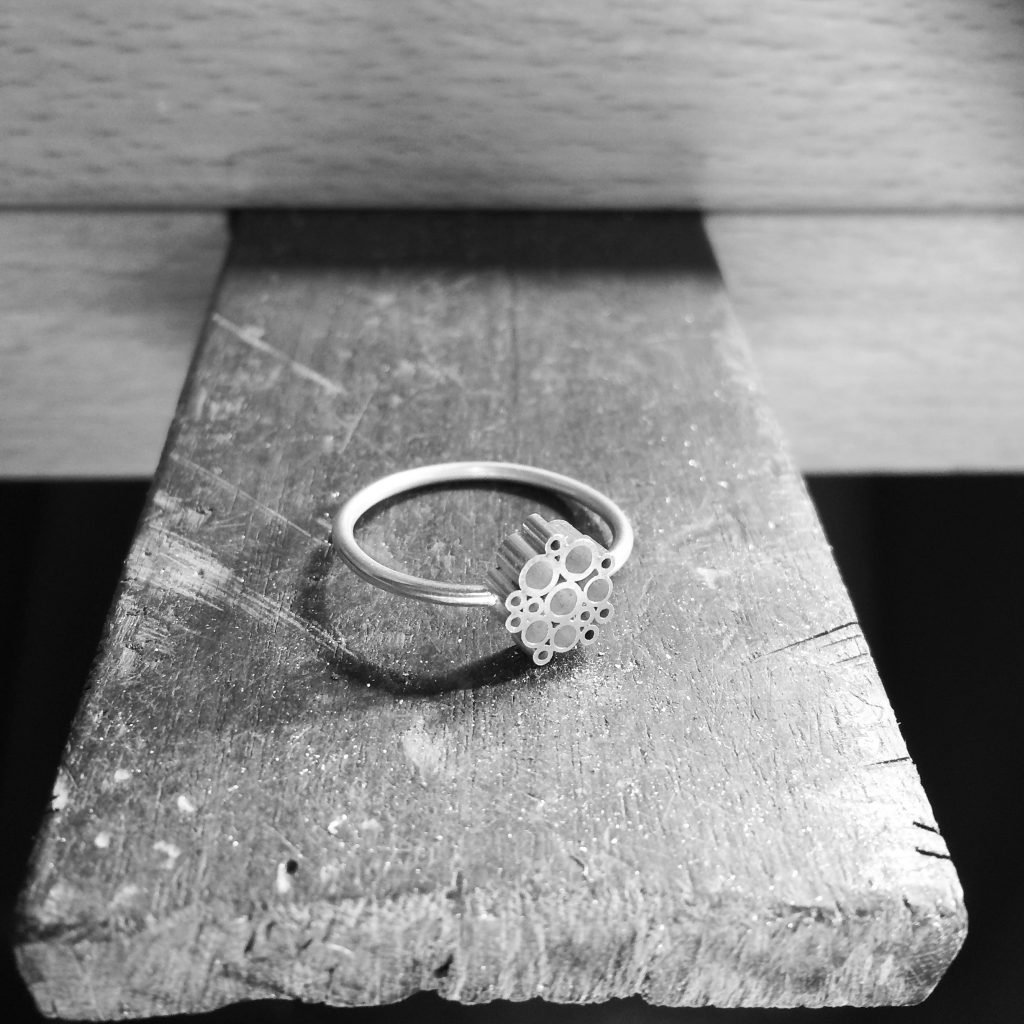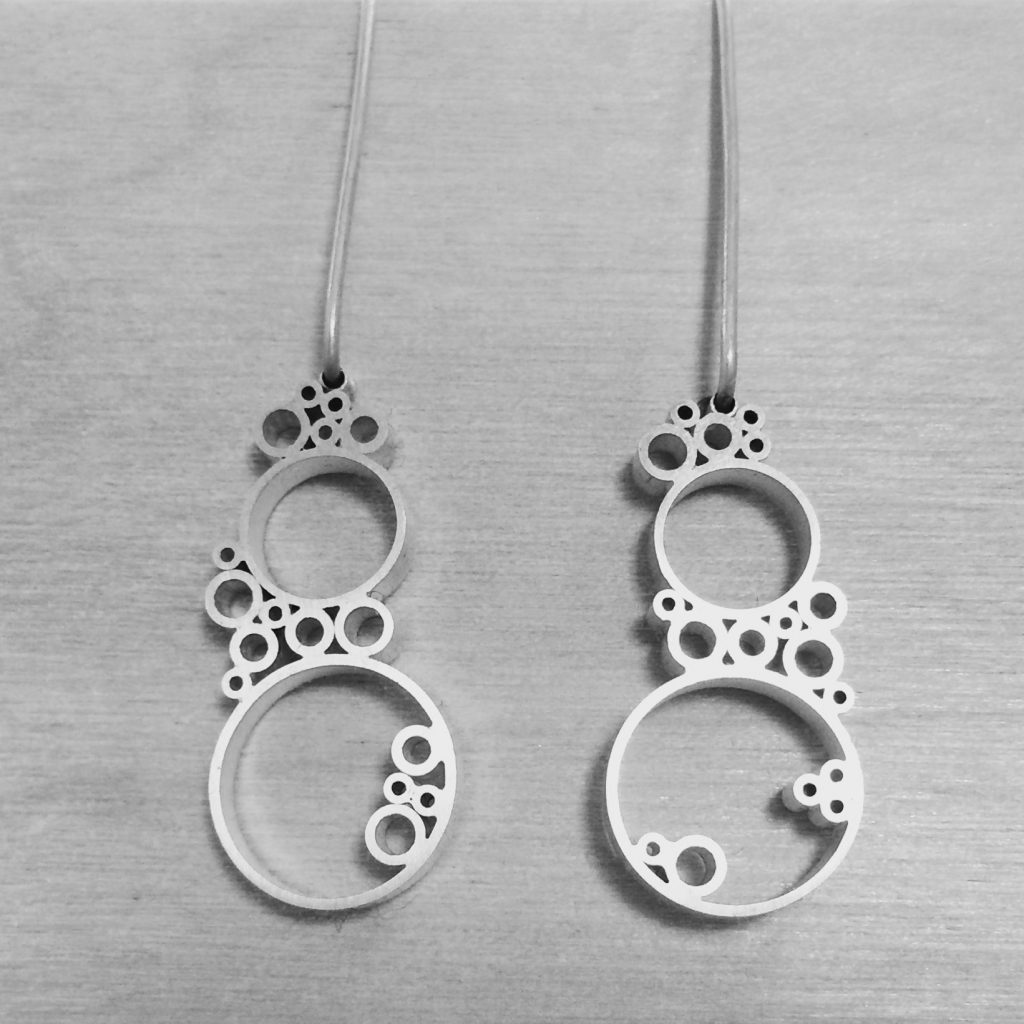Metalwork

Surface Tension Necklace, 2017. Sterling silver. Photo Lan Nguyen-hoan.

Surface Tension Necklace 2, 2017. Sterling silver. Photo Lan Nguyen-hoan.

Surface Tension Studs Collection, 2016. Sterling silver.

Surface Tension Studs Collection, 2016. Sterling silver.

Surface Tension Ring, 2016. Sterling silver, ruby.

Surface Tension Ruby Anniversary Ring, 2016. 18ct yellow gold, sterling silver, 0.65ct Burmese ruby.

Surface Tension Ring, 2016. Sterling silver.

Surface Tension Ring, 2016. Sterling silver.

Surface Tension Drop Earrings, 2016. Sterling silver.

Surface Tension Bracelet, 2016. Sterling silver.

Surface Tension Drop Earrings, 2016. Sterling silver, aquamarine.

LM IIIA1 Hydria, 2012. Copper. Height 44 cm. Photo Johannes Kuhnen.
Based on the vessel type produced in Minoan Crete, this copper hydria was created with Bronze Age technology during the doctoral research project "The Manufacture of Minoan Metal Vessels: Theory and Practice", 2008-2012.

Lamp: Opposing Fibonacci Logarithmic Spirals, 2007. Silver-plated gilding metal, high-power LED, electrical components. Diameter 150mm. Photo Johannes Kuhnen.
This portable, wireless lamp was created for the research project 'Search for a Universal Aesthetic' in the Australian National University School of Art Gold and Silversmithing Workshop. The sphere was hammered from sheet gilding metal (a copper alloy containing 95% copper and 5% zinc), the patterns were drilled and the pieces silver plated. The lamp contains high-power LEDs which are powered by a rechargeable Nickel Metal Hydride (NiMH) battery, charged via a socket in the base of the sphere. The pattern on the sphere is based on the natural phenomenon of the pattern of opposing logarithmic spirals with proportions based on the Fibonacci sequence (also called a Fibonacci spiral or golden spiral). An approximation of this pattern is found in the structure of pinecones and sunflowers.

Lamp: Hexagonal Close-Packing, 2007. Silver-plated gilding metal, high-power LED, electrical components. Diameter 150mm. Photo Johannes Kuhnen.
This portable, wireless lamp was created for the research project 'Search for a Universal Aesthetic' in the Australian National University School of Art Gold and Silversmithing Workshop. The sphere was hammered from sheet gilding metal (a copper alloy containing 95% copper and 5% zinc), the patterns were drilled and the pieces silver plated. The lamp contains high-power LEDs which are powered by a rechargeable Nickel Metal Hydride (NiMH) battery, charged via a socket in the base of the sphere. The pattern on the sphere is based on the natural phenomenon of hexagonal close-packing. This is most commonly seen in the structure of honeycomb, where its construction is usually perfect. Perfect hexagonal close packing is mathematically impossible on a sphere, and must be interspersed with seven- and five-sided polygons in order for the pattern to cover the sphere. This structure can be found on some microscopic organisms such as radiolaria.

Lamp: Multi-Point-Source Wave Interference, 2007. Silver-plated gilding metal, high-power LED, electrical components. Diameter 150mm. Photo Johannes Kuhnen.
This portable, wireless lamp was created for the research project 'Search for a Universal Aesthetic' in the Australian National University School of Art Gold and Silversmithing Workshop. The sphere was hammered from sheet gilding metal (a copper alloy containing 95% copper and 5% zinc), the patterns were drilled and the pieces silver plated. The lamp contains high-power LEDs which are powered by a rechargeable Nickel Metal Hydride (NiMH) battery, charged via a socket in the base of the sphere. The pattern on the sphere is based on the natural phenomenon of multi-point-source wave interference. This pattern is most commonly seen when the surface of still water is broken at multiple points by drops of water or by other objects such as stones.

Lamp: Randomisation, 2007. Silver-plated gilding metal, high-power LED, electrical components. Diameter 150mm. Photo Johannes Kuhnen.
This portable, wireless lamp was created for the research project 'Search for a Universal Aesthetic' in the Australian National University School of Art Gold and Silversmithing Workshop. The sphere was hammered from sheet gilding metal (a copper alloy containing 95% copper and 5% zinc), the patterns were drilled and the pieces silver plated. The lamp contains high-power LEDs which are powered by a rechargeable Nickel Metal Hydride (NiMH) battery, charged via a socket in the base of the sphere. The pattern on the sphere is based on the natural phenomenon of randomisation, as far as randomisation is actually possible.

Bubble Rings, 2006. Sterling silver, 9ct gold. Photo Johannes Kuhnen.

Bubble Rings, 2006. Sterling silver. Diameters approx. 40mm. Photos Johannes Kuhnen.

Bubble Rings, 2006. Sterling silver. Photo Johannes Kuhnen.

River Stone Necklace, 2005. Stone, monel, sterling silver. Dimensions variable. Collection of the Australian National University Jewellery + Object Studio. Photo Johannes Kuhnen.

Pebble Rings, 2005. Sterling silver, river stones. Photo Johannes Kuhnen.

Pebble Rings, 2005. Sterling silver, river stones, garnet, topaz, peridot. Photo Johannes Kuhnen.

